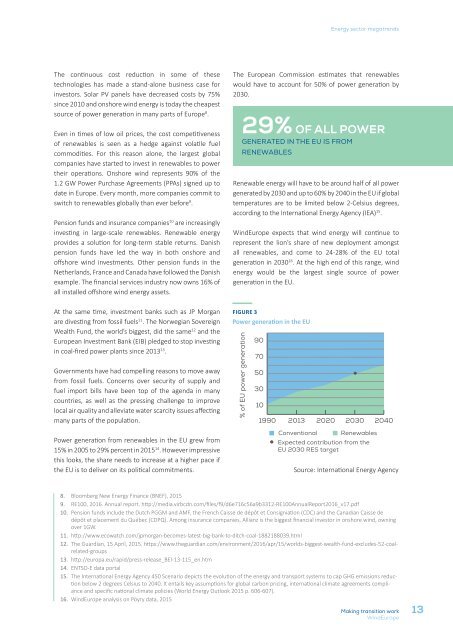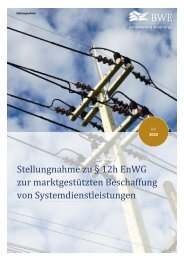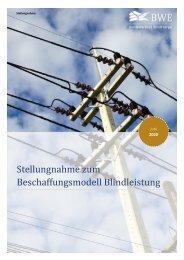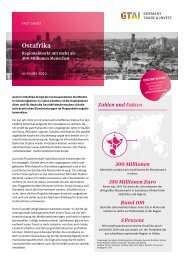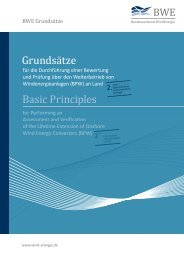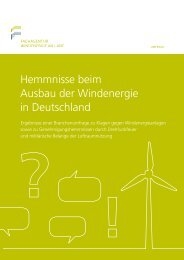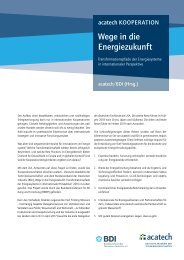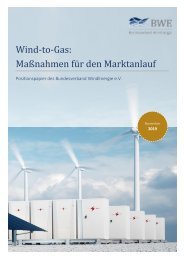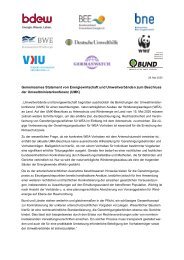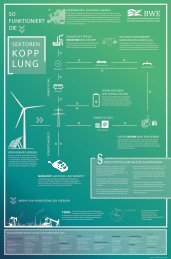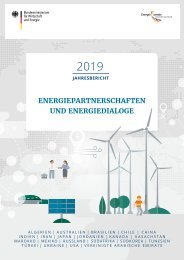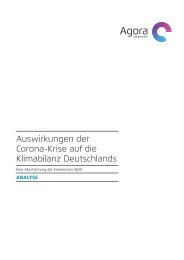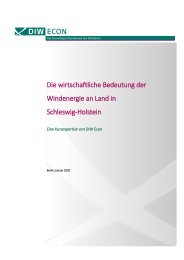Making transition work - Wind Europe
This report provides clear elements on how to make transition work in the coming decade. It provides recommendations to policymakers on how to facilitate a swift transformation of the energy system and considers the policies that will make Europe the best choice for those investing in renewables.
This report provides clear elements on how to make transition work in the coming decade. It provides recommendations to policymakers on how to facilitate a swift transformation of the energy system and considers the policies that will make Europe the best choice for those investing in renewables.
Create successful ePaper yourself
Turn your PDF publications into a flip-book with our unique Google optimized e-Paper software.
Energy sector megatrends<br />
The continuous cost reduction in some of these<br />
technologies has made a stand-alone business case for<br />
investors. Solar PV panels have decreased costs by 75%<br />
since 2010 and onshore wind energy is today the cheapest<br />
source of power generation in many parts of <strong>Europe</strong> 8 .<br />
Even in times of low oil prices, the cost competitiveness<br />
of renewables is seen as a hedge against volatile fuel<br />
commodities. For this reason alone, the largest global<br />
companies have started to invest in renewables to power<br />
their operations. Onshore wind represents 90% of the<br />
1.2 GW Power Purchase Agreements (PPAs) signed up to<br />
date in <strong>Europe</strong>. Every month, more companies commit to<br />
switch to renewables globally than ever before 9 .<br />
Pension funds and insurance companies 10 are increasingly<br />
investing in large-scale renewables. Renewable energy<br />
provides a solution for long-term stable returns. Danish<br />
pension funds have led the way in both onshore and<br />
offshore wind investments. Other pension funds in the<br />
Netherlands, France and Canada have followed the Danish<br />
example. The financial services industry now owns 16% of<br />
all installed offshore wind energy assets.<br />
The <strong>Europe</strong>an Commission estimates that renewables<br />
would have to account for 50% of power generation by<br />
2030.<br />
29% OF ALL POWER<br />
GENERATED IN THE EU IS FROM<br />
RENEWABLES<br />
Renewable energy will have to be around half of all power<br />
generated by 2030 and up to 60% by 2040 in the EU if global<br />
temperatures are to be limited below 2-Celsius degrees,<br />
according to the International Energy Agency (IEA) 15 .<br />
<strong>Wind</strong><strong>Europe</strong> expects that wind energy will continue to<br />
represent the lion’s share of new deployment amongst<br />
all renewables, and come to 24-28% of the EU total<br />
generation in 2030 16 . At the high end of this range, wind<br />
energy would be the largest single source of power<br />
generation in the EU.<br />
At the same time, investment banks such as JP Morgan<br />
are divesting from fossil fuels 11 . The Norwegian Sovereign<br />
Wealth Fund, the world’s biggest, did the same 12 and the<br />
<strong>Europe</strong>an Investment Bank (EIB) pledged to stop investing<br />
in coal-fired power plants since 2013 13 .<br />
Governments have had compelling reasons to move away<br />
from fossil fuels. Concerns over security of supply and<br />
fuel import bills have been top of the agenda in many<br />
countries, as well as the pressing challenge to improve<br />
local air quality and alleviate water scarcity issues affecting<br />
many parts of the population.<br />
Power generation from renewables in the EU grew from<br />
15% in 2005 to 29% percent in 2015 14 . However impressive<br />
this looks, the share needs to increase at a higher pace if<br />
the EU is to deliver on its political commitments.<br />
FIGURE 3<br />
Power generation in the EU<br />
% of EU power generation<br />
90<br />
70<br />
50<br />
30<br />
10<br />
1990 2013 2020 2030 2040<br />
Conventional<br />
Renewables<br />
Expected contribution from the<br />
EU 2030 RES target<br />
Source: International Energy Agency<br />
8. Bloomberg New Energy Finance (BNEF), 2015<br />
9. RE100, 2016. Annual report. http://media.virbcdn.com/files/f9/d6e716c56a9b3312-RE100AnnualReport2016_v17.pdf<br />
10. Pension funds include the Dutch PGGM and AMF, the French Caisse de dépôt et Consigniation (CDC) and the Canadian Caisse de<br />
dépôt et placement du Québec (CDPQ). Among insurance companies, Allianz is the biggest financial investor in onshore wind, owning<br />
over 1GW.<br />
11. http://www.ecowatch.com/jpmorgan-becomes-latest-big-bank-to-ditch-coal-1882188039.html<br />
12. The Guardian, 15 April, 2015. https://www.theguardian.com/environment/2016/apr/15/worlds-biggest-wealth-fund-excludes-52-coalrelated-groups<br />
13. http://europa.eu/rapid/press-release_BEI-13-115_en.htm<br />
14. ENTSO-E data portal<br />
15. The International Energy Agency 450 Scenario depicts the evolution of the energy and transport systems to cap GHG emissions reduction<br />
below 2 degrees Celsius to 2040. It entails key assumptions for global carbon pricing, international climate agreements compliance<br />
and specific national climate policies (World Energy Outlook 2015 p. 606-607).<br />
16. <strong>Wind</strong><strong>Europe</strong> analysis on Pöyry data, 2015<br />
<strong>Making</strong> <strong>transition</strong> <strong>work</strong><br />
<strong>Wind</strong><strong>Europe</strong><br />
13


